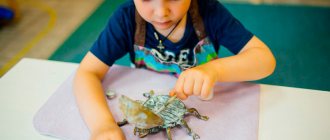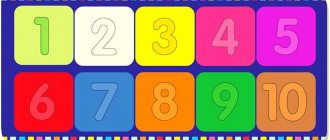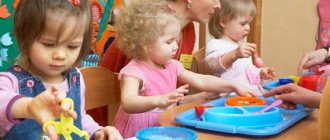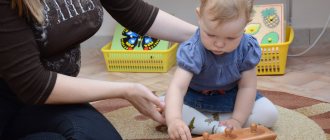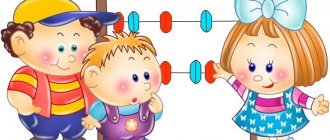Various methods of early development of children are popular among modern parents. But since the main activity for children is play, many of the systems are built accordingly, in particular, Montessori games. The author, Maria Montessori, offers not just a theoretical approach, but also specific options for educational fun for children aged 2-4 years. We invite you to get to know some of them.
Didactic and educational games according to the Montessori system
Montessori games for children are built on the principle of complete independence. Children choose their own materials, pace and rhythms of play. If a child gets bored with one activity, he can change the environment and material at any time. The most important feature is considered to be the right to choose the direction in which the baby would like to develop.
The principle of the Montessori system
The task of parents and teachers is to create a large subject environment. All elements that a child can use to play must be accessible. Educators must respect choice. The goals of education are to create the most comfortable environment in which full development will take place. The child should act both as an observer and as an assistant, if necessary. You can’t strive to make your baby like you. Montessori believes that it is unacceptable to interfere with the process of personality development.
Note! The goals of an adult during a lesson using the Montessori method are to help the child in an effort to develop his independence, to give hints only at the moment when he asks for it. It is strictly forbidden to force a child to do anything.
What are they and what are they aimed at
In the process of developing her methodology, Maria Montessori spent a long time observing the behavior of children in play. Due to this, classes are divided into different areas:
- Mathematical, aimed at developing mental abilities.
- Language to develop communication and cognitive skills.
- Sensory, designed to develop senses of vivid perception of the environment.
- Exercises aimed at developing practical and everyday skills.
- Space so that a child can find his own place in this world.
The purpose of Montessori didactic games is to help children and their spiritual and mental development. The child needs to choose such didactic material on which he will fully concentrate. All aids should be kept as simple as possible, as adult intervention is not recommended. That is, conditions must be created for the child under which he will not only be able to find the mistake himself, but also correct it.
Principles of working with didactic material:
- All elements for games should be located at eye level. This will encourage the child to be active.
- Use of the material is possible only after the parent explains its purpose.
- The work should be carried out in stages, from simple techniques to more complex ones.
- A child can work with material not only according to the principle established by an adult. He can independently apply knowledge.
- It is important to teach your child that after completing each lesson, he himself returns the material to its place. Only after this can he begin another game.
- The elements are laid out in a certain order in front of the baby on a rug or table.
Note! If group classes are held, then one child should work with one material; there should be no transfer of elements from hand to hand to another participant.
Didactic elements
What is the Montessori method?
The essence of the Montessori method is to reveal its main postulate, which says “Help me do it myself.” Based on this, we can formulate the main postulate of the Montessori method as follows: “performing a child’s actions with minimal help from an adult”, in other words, developing independence.
The Montessori method is recognized as an alternative to traditional pedagogy. It is used in working with children from 3 to 6 years old when they attend classes on their own, that is, parents are not present. From 8 months to one and a half to two years, children come to class with their parents. It may seem that the Montessori method is a completely unorganized system. But this is only at first glance.
The main idea of the Montessori method is a wonderful example of practical pedagogy in the implementation of ideas in the free education of children from a very early age, promoting their independent development.
Sent for sorting
Games focused on the sorting principle are aimed at developing visual skills and help train other organs. As a game activity you can offer:
- Sorting items from 2 to 5 years old. It can be both in shape and color. The lesson develops attentiveness and logic. For the activity you need to take several sets of objects according to size, shape and color. Playing with buttons has a good effect on development. You need to take a large number of buttons, in which there will be five or six identical ones. Mix all the buttons in a bowl, then show your child which type to choose.
- An excellent activity for sensory development is wooden cubes of various sizes. You can buy cubes that are inserted into each other, like a nesting doll.
- A pyramid would be a good activity for children aged two years and older. It can be of any type, but the principle is the same. Such a toy should have one rod and a set of elements. The child's task is to find identical shapes, for example, circles.
- You can choose simple puzzles as a sorting game. In the Montessori method, wooden ones with beautiful pictures are selected. For children under four years old, you should choose puzzles in which each element has a handle to make it easy to hold. It is recommended to avoid cardboard frames.
Pyramid game
Five principles proposed by M. Montessori
- The child is active . The adult acts as an assistant, his role is secondary. The child needs to be interested, and he will develop himself. Classes take place in a specially prepared environment.
- The child is his own teacher . He has full freedom of action and choice. Children teach each other according to the principle from older to younger, which allows them to learn to care for others;
- Child's independence in decision making;
- Full self-development is a consequence of freedom in actions, thinking, and feelings. A child becomes himself when we follow the instructions of nature, and do not go against them.
- Respect for children – absence of prohibitions, criticism and instructions. A child has the right to make mistakes and figure everything out on his own.
In order to understand what the Montessori method is, it is enough to follow its theory and agree with the belief that any child is a normal person, capable of discovering himself in active work
Matching games
Matching games are the most popular Montessori activities for ages 1 to 3. The main types are:
- Activities with colors - you can offer your child a cardboard circle with multi-colored sectors and clothespins of the same shades. The child must independently choose his own clothespin for each sector.
- The game can be combined with the help of mom. For example, invite your child to sort washed socks into pairs.
Step-by-step technique for drawing a portrait of a mother for children
This group of classes develops logic and attention.
Games with colors
"My home is my castle". Montessori recommendations for arranging a home for a baby aged 1-2 years.
Montessori teachers always remind that the environment for the child should be comfortable and safe. It’s not so easy to grow and become independent when you are literally surrounded by insurmountable obstacles everywhere: chairs twice your height, a sink the size of an elephant, a cup that cannot be lifted and a spoon that does not fit into your mouth.
Before planning a Montessori lesson, look around your home and make sure your child has everything he needs:
- Comfortable place to sleep. The child must be able to lie down and get out of bed without adult help,
- Safe movement in the space allocated for the child. Close the sockets with special plugs, remove the wires, make sure that all furniture and decorative elements are securely fastened,
- Comfortable temperature and warm floor. Kids move around the floor a lot, so it’s worth covering it with warm carpets in advance or thinking about heated floors,
- Children's size furniture and tools: low chairs, table, shelves, drawers, ladder for access to the sink, convenient dishes
- An organized and accessible area for Montessori developmental activities. Use baskets, trays and bags for sorting and place the material on low shelves so that the baby can reach interesting items himself.
Classes using the Montessori method using sequences of actions
Montessori games are aimed at the ability to determine the sequence of actions. This helps the development of logical thinking. Such classes are successfully used not only for young children, but also for preparatory groups of kindergarten and primary school students. For younger and middle-aged children, an excellent game option would be to show the fairy tale “Kolobok”, in which the child will be able to correctly tell the sequence.
You can suggest a game of cylinder blocks. During the process, the child must arrange objects in the correct sequence. For this purpose, blocks and cylinders with holes are used, which are strung on the structure.
Action Sequence Development
Pros and cons of the system
Like any system, the Montessori method has opponents and admirers. It will be easier for most people to figure out which group they belong to after they become familiar with the pros and cons of the system.
pros
Among the advantages of the system are:
- the adult has virtually no influence on the development of children or makes only minor interference, which allows the child to master the world without imposed prejudices;
- the technique allows children to express themselves and takes into account individual characteristics;
- children are not forced, but motivated to learn, they are not praised, but they are not scolded either, so the learning process is not so traumatic;
- children gain freedom, independence and develop the ability to independently plan and organize their activities;
- the system takes into account the periods of children's development, improves fine motor skills, develops senses;
- quickly instills skills of self-service, responsibility, and self-control;
- develops intelligence, speech, logical and analytical thinking;
- gives an idea of world realities and contacts with other people (if the child is brought up according to this system and in a group).
There is no need to set aside any time to use the Montessori system. The beauty of this technique is that you don’t do it periodically, but live in it. Moreover, this form of living is quite convenient for adults. Children develop themselves at a pace that is convenient for them, and the adult’s task is to provide the baby with everything necessary and monitor his safety. In addition, this technique is “inexpensive”. All equipment is inexpensive, especially if you make it yourself.
Minuses
The method also has some drawbacks:
- greater emphasis on the intellectual side of the child’s development to the detriment of his emotionality and creative inclinations;
- ignoring role-playing games, arguing that they distract the child;
- omissions related to the temperamental characteristics of children (not all children will ask for help, and not everyone will be interested);
- the methodology is fundamentally different from the methods of education and presentation of material in kindergartens and schools, which creates difficulties for the child in adapting to the school schedule and the peculiarities of interaction with teachers;
- lack of physical activity.
Given these shortcomings, classical Montessori is rarely implemented in its “pure” form. More active games and elements of control over the child’s activities are added to it, so that it is easier for him to socialize in educational institutions.
Montessori exercises: developing fine motor skills
The development of fine motor skills in early and middle age is one of the important areas of pedagogical activity. Playing with laces is a great way to develop fine motor skills. You can use a wooden shoe sample or draw it on cardboard.
For girls, you can offer a game with beads of different shapes and sizes. They will string them on laces. It is important that both beads and laces are multi-colored.
Note! The most accessible material for Montessori games is paper. Children develop motor skills by cutting out stripes, figures, and various patterns.
Fine motor skills activities
Development of self-care skills in children
Game for developing fine motor skills “Cinderella”
Purpose of the game: development of the child’s fine motor skills, development of the eye, development of the skill of working independently, concentrating, coordinating movements, working according to the order of actions, being able to sort (identify the main features, priorities, etc.), speech development.
Required materials: tray, 3 bowls, 3 types of cereal (additionally, you can offer tongs, Chinese chopsticks)
Progress of the game:
- Place three empty bowls on a large tray.
- Place a handful of seeds in the middle of the tray: beans, peas, beans.
- Invite your child to play “Cinderella” and sort the seeds into different bowls with their fingers.
- Show an example of how to lay it out. Tell your child the names of the seeds and ask how they differ? How are they similar (color, shape, feel)?
- If the child copes, then move away and let him finish the game on his own. Be sure to praise at the end of the game
- Boil the disassembled seeds and let your child taste them. Find out how they differ in taste.
- The lesson is considered completed when all tools are put back in their place. There is no waste left in the workplace. The table has been wiped with a cloth. The child must do all this independently.
Advanced game options:
- Sort seeds by touch while blindfolded
- Take smaller grains for the game: buckwheat, rice, semolina
- Take a larger number of cereals for the game (4-5-6 types)
- Disassemble the seeds with tweezers (Chinese chopsticks)
The game can be played either individually or in a group.
Educational game "Lacing"
Purpose of the game: development of the child’s fine motor skills, development of the eye, development of the skill of working independently, concentrating, coordinating movements, working according to the order of actions, preparing for sewing with a real needle.
Materials needed: colored laces, cardboard figures with hole punch holes
Progress of the game:
- Give the child a string and a cardboard blank. Invite your child to lace up the second cardboard “shoe.”
- Show and explain on the first “shoe” how to hold the lace, how to thread it through the holes, and in what order the two ends of the lace should be threaded.
- Let your child do the lacing on the second cardboard sample. Give praise when done correctly.
- If the child makes a mistake and does something wrong, offer to unlace his “shoe”, look carefully at your sample, think and try to complete the task again.
- After successful execution, teach your child to tie a bow from laces. Demonstrate a sample of the bow on your “boot”. The child then tries to do it on his own.
- If it doesn't work, untie your bow and show it again. Continue this way until the child is able to do it on his own.
- To reinforce the skill, have your child lace up real shoes and tie a bow. Be sure to support your child with praise. It’s a good idea to praise the child about such a “feat” in front of other significant adults (father, grandmother or grandfather). This will give the child confidence in future tasks.
- The lesson is considered completed when all tools are put back in their place. There is no waste left in the workplace. The table has been wiped with a cloth. The child must do all this independently.
Advanced game options:
- Offer more complex “boot” lacing.
- Invite the child to look at the new lacing pattern without demonstration from an adult and try to make it himself on his own “shoe” sample.
- Prepare other templates (matryoshka, giraffe, elephant, house) and offer to make patterns with laces using the “sewing” or “embroidery” technique
Educational game "Braids"
C
spruce games: training concentration, development of fine motor skills of the fingers, eye-hand coordination.
Necessary materials: Prepare two cardboard blanks with attached thread pieces for weaving. They are also on sale.
Progress of the game:
- Give the child a cardboard blank with loose “hair” in his hands.
- Show and explain in the first example how to weave a simple braid.
- Let your child do the weaving on the second cardboard sample. Give praise when done correctly.
- If the child makes a mistake and does something wrong, offer to undo the braid, look carefully at your sample, think and try again to complete the task.
- If the braid is successful, offer to tie the braid with a bow. Demonstrate with your example and ask your child to do the same.
- Praise your child for his diligence and accuracy.
- The lesson is considered completed when all tools are put back in their place. There is no waste left in the workplace. The table has been wiped with a cloth. The child must do all this independently.
Advanced game options:
- Suggest braiding a lot of small braids on the sample.
- Offer a more complex braid (4 strands, 5 strands)
Educational game “Neat hands”
Purpose of the game: training concentration, development of fine motor skills of the fingers, eye-hand coordination, learning to cut nails using a nail clipper and scissors
. Materials needed: Two cardboard blanks of hands with images of nails.
Progress of the game:
- Give the child a cardboard hand blank.
- Point to the nail plates, compare them with those drawn and explain to the child that nails need to be trimmed and this can be done with two tools: a nail biter, scissors.
- Tell your child that you can’t cut close to the skin, because it will cut and bleed. To help your child understand how to cut, suggest using a pencil to draw a cutting line on the workpiece.
- Demonstrate this on your workpiece.
- Let your child independently draw the cutting line on the second cardboard sample. Give praise when done correctly.
- Demonstrate how to cut a nail with a nail biter.
- Invite your child to perform the action independently. Give praise when done correctly.
- The lesson is considered completed when all tools are put back in their place. There is no waste left in the workplace. The table has been wiped with a cloth. The child must do all this independently.
Advanced game options:
- Suggest performing the same steps using scissors.
- Offer to trim the “nails” on the sample without drawing a cutting line using scissors.
- You can offer the girl to paint her nails in some color and decorate her jewelry as she wishes.
Games based on the Maria Montessori method - exercises with liquids
Do-it-yourself Montessori classes are very easy to organize. In childhood, babies love to play with water. Activities related to liquids will arouse true interest. For example, you can suggest pouring water from one vessel to another; they should differ in shape. It is important not to spill anything during the game.
Note! A simple everyday activity can easily be turned into a game. You can invite your child to pour the juice into a glass themselves. This exercise will teach him independence and accuracy. If he accidentally spills juice, you need to tell him how to clean up after himself.
Exercises with liquid
Montessori games for early development: small objects
Transferring small objects (coins, beads, pebbles) from one vessel to another using tongs or a spatula is a rather difficult task for small fingers. But it develops the child’s fine motor skills well.
Interesting and fun children's performances
Beans, buckwheat, rice and other cereals are also good for playing with small objects.
Sensory development
Sensory development in children
Game for the development of fine motor skills “Torn Applique”
Purpose of the game: development of fine motor skills of the fingers, eye-hand coordination, development of creative thinking
Materials needed: Coloring sheet, colored paper, old magazines
Progress of the game:
- Show your child that you can color a picture not only with paints and pencils, but also with scraps of colored paper.
- Show your child how to carefully pinch off the desired piece of color and glue it to the drawing.
- Offer to “decorate” the drawing yourself in this way.
- The lesson is considered completed when all tools are put back in their place. There is no waste left in the workplace. The table has been wiped with a cloth. The child must do all this independently.
Advanced game options:
- Invite your child to “decorate” the picture using crumpled paper balls. Teach your child to crumple paper and roll paper balls from the crumpled sheets, and then glue them. Pay attention to the surface of the pattern that such a volumetric applique looks good for making the fur coat of an animal, for example a lamb.
- Invite your child to design the drawing using strips of paper rolled into snails. Teach your child to carefully roll and glue paper strips. Pay attention to the beautiful paper ornament of such work.
Awareness game “The Cheerful Gardener”
Purpose of the game: development of fine motor skills of the fingers, sensory skills, development of visual memory, attention coordination
Required materials: ten apples (pears, oranges) of the same variety
Progress of the game:
- Place 10 prepared fruits of the same variety on the table in front of the child. Show your child that they are all the same, but each has its own characteristics.
- Take one apple in your hand and demonstrate how it differs from the others (for example, the absence of a stick or a speck or color is different)
- Invite your child to choose one fruit and, after carefully examining it, find the differences from the others. Let him name all the differences out loud.
- Return all the apples to the table, ask the child to turn away, and stir.
- Invite your child to find his own apple among others.
- The lesson is considered completed when there is no trash left in the workplace. The table has been wiped with a cloth. The child must do all this independently.
- The game is more fun and educational with the entire Ifamily.
Advanced game options:
- Offer your child more fruits (15-20 pieces)
- Offer your child less varied samples: walnuts, apricots, plums
The game can be played either individually or in a group.
Family game “Bouquet for Mom”
Purpose of the game: development of fine motor skills of the fingers, sensory skills, development of visual memory, coordination of attention
Necessary materials: wild and garden flowers, water, vase (jar)
Progress of the game:
- Place the prepared flowers on the table in front of the child.
- Pour water into the jar, showing the level to the child. If you spill water, wipe it off with a cloth.
- Show your child how to prepare flowers in a bouquet: cutting off the lower leaves and a piece of the stem, aligning the length of the flower stem.
- Demonstrate how to arrange flowers in a vase (jar), adding one at a time.
- Give your bouquet to the child, saying good wishes to him.
- Invite your child to repeat all the steps.
- If a child makes a mistake (for example, cuts a stem too short), do not interfere with him, let him notice it himself.
- After work, offer to clean up the table together and arrange bouquets at home.
Sensory development game “Wonderful Bag”
C
spruce games: development of fine motor skills of fingers, sensory skills, development of tactile memory, attention coordination
Materials needed: opaque bag, small items that fit in your hand, Kinder Surprise toys, bottles, school supplies, etc.
Progress of the game:
- Find at home a regular opaque bag made of fabric or linen in which you can put small objects: plastic or wooden geometric shapes, voluminous bottles, small fabric toys, Kinder Surprise toys, various stones.
- Invite your child to put his hand into the bag and find something with his hands.
- Next, without pulling out the object, you need to feel it with your hand, describe what it is made of, what it consists of, and suggest what it could be.
- Take out the object and make sure your answer is correct or incorrect.
- This educational game is fun to play with the whole family, forming a queue. Parents can set an example for their child on how to correctly describe an object and what to pay attention to when guessing.
Game for the development of visual perception “Simple puzzles”
Purpose of the game: development of fine motor skills of the fingers, visual perception, development of visual memory, coordination of attention.
Materials needed: old postcards, scissors.
Progress of the game:
- Place old postcards on the table in front of your child. Offer to choose one.
- When the child makes his choice, ask him to carefully look at the postcard and remember what is where.
- Then, in front of the child’s eyes, you cut the picture into 8-10 squares. (If the child is small, then it is enough to cut into 4-6 squares the first time). Mix up the parts of the card.
- Ask your child to put this puzzle together correctly.
- If the child copes, then the next picture can be cut into smaller parts (triangles, polygons).
- If the child cannot cope, do not scold, put this puzzle aside. He'll collect it later. Practice with simpler options by cutting the card into fewer pieces.
- It is better to store each cut puzzle in a separate envelope.
- The next day and beyond, the child will return to this game. And it will have a different developmental meaning, because the visual image of the postcard will already be forgotten by the child. And you will need to use your thinking to create a picture.
- The lesson is considered completed when there is no trash left in the workplace. The table has been wiped with a cloth. The child must do all this independently.
On the development of a child’s sensory and fine motor skills, read also:
Child sensory development “Sand therapy”
Development of fine motor skills “Drawing with plasticine”
Games based on the Montessori method for sensory development
Sensory activities are very exciting for the kids. One of these games is a bag, in which they must identify the object by touch. This causes great delight in the kids as soon as they guess.
For Montessori games, DIY materials may include making sound cylinders. They are made from any containers or boxes that can be filled with cereals, pebbles, and coins. Such items develop hearing acuity in children.
Note! Finger painting is considered one of the most exciting activities. During its implementation, the baby can develop fine motor skills, imagination and curiosity.
Fun drawing
Classes using the Montessori method for children - everyday life and housekeeping
Both younger and older children are very keen on helping their parents with household chores. They take this very seriously and begin to learn to realize responsibility. Once you start trusting your child to brush his teeth and put dirty things in the basket, he will begin to do this every day, as a habit without a reminder.
Note! Buttons on clothes will be an excellent element of playful activities in everyday life. The more your baby practices fastening them on his own, the faster he will master this process.
It is useful to involve the child in doing household chores. For example, give him the opportunity to wipe the dust, wash the dishes, and set the table. It is important not to redo anything in front of the baby.
Doing household chores
DIY Montessori games, what and how you can make them
The technique pays great attention to sensory skills, so it is recommended to make toys from natural materials. First of all, you need to make sure of their safety. If a DIY Montessori toy is made of wood, it should be well hewn and painted with non-toxic paint.
One of the most popular didactic games is the creation of cards on various topics. You can either draw them yourself or print them on a printer. Drawings should be bright and expressive. The card index can be dedicated to animals and their babies, vegetables and fruits, equipment, clothing. For example, rubber or painted animals are given out, and the child must find the corresponding card with a description for them.
Note! You can make your own sensory mats at home. You can use an old thick blanket or a large towel as a basis. Buttons are sewn onto the material as desired, and appliqués are made on various themes. Such toys develop sensory skills and prevent flat feet.
It is important that all activities are focused on the interests of the child. Parents and educators only observe their changes from the outside in order to promptly propose a new stage of development.
